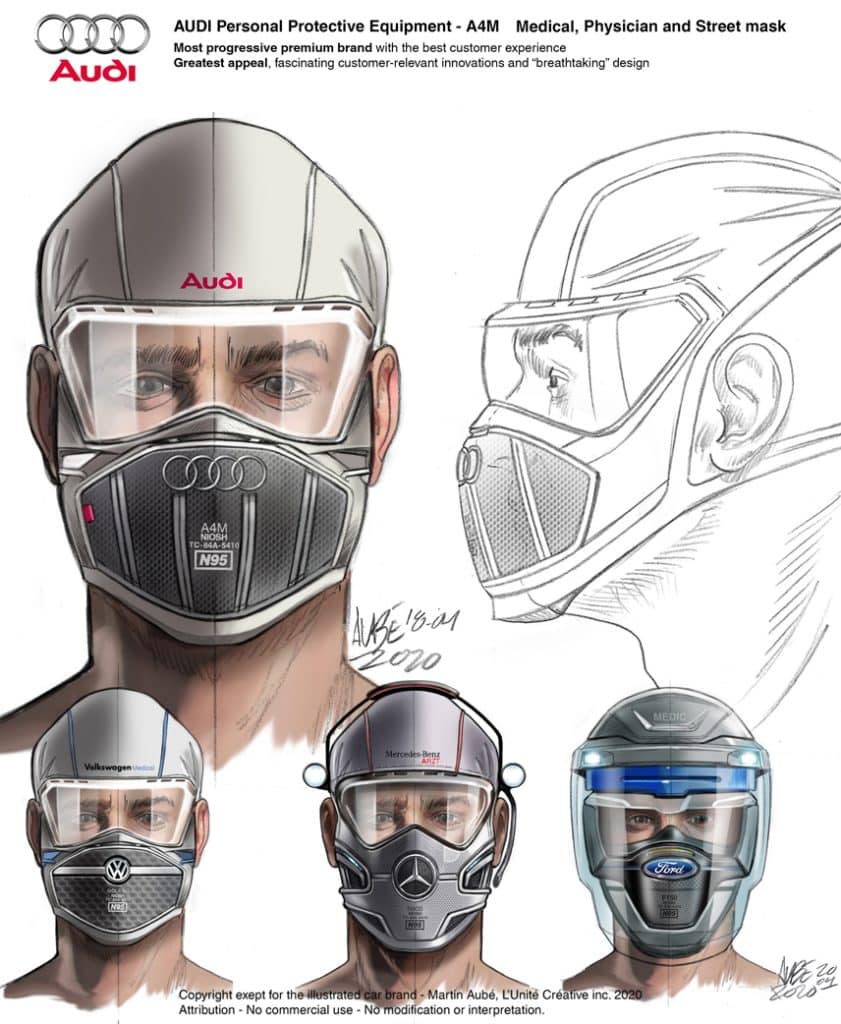What if major automobile manufacturers launched into the design and manufacturing of personal protective masks? Martin Aubé, IDSA, industrial designer and president of Creative Unit in Saint-Bruno, Quebec asked himself this question in April 2020 after reading that Ford and GE would produce 50,000 ventilators in 100 days to help in combatting the global coronavirus pandemic.
The following is a translation of a French article profiling Aubé in Montreal’s LaPresse newspaper, written by senior journalist Marc Tison:
It’s in the nature of an industrial designer: he seeks to improve products, processes and procedures. For the past two months, industrial designer Martin Aubé has seen hospital staff try as best they can to put on masks, visors and imitation bathing caps, and asked himself if it would be possible to create a more effective and rewarding product.
The final impulse came on April 20, when Aubé learned that Ford was partnering with GE Healthcare to urgently manufacture 50,000 respirators. “Is it going to be developed by engineers and designers from Ford?” he wondered. “It would be funny if it came out with the Ford branding logo!” An F150 large displacement respirator, for example.
He broadened the reflection: perhaps we will come to ask the automobile manufacturers to manufacture respiratory masks. How would they print their identity on them? He has tackled the problem himself.

Aubé worked for 17 years at Bombardier Recreational Products, designing vehicles of all kinds. A bit of a bear, by the way, he has been working for 16 years in his den in Saint-Bruno, designing car bodies and concepts for a long list of Quebec manufacturers. The original design of Quebec’s electric motorcycle Lito Sora was his. Every year, Aubé sends greetings cards to customers and friends in a fun illustration with style and humor reminiscent of the great French cartoonist Gotlib, creator of Rubrique-à-brac.
Auto designers generally try to give a personality to the front of vehicles by giving them features inspired by human faces, Aubé says. He went the opposite route here, extracting the visual DNA of the automobile brand to restore it in a face protection device.
The functional aspect has not been overlooked. Healthcare workers can easily put on and take off the device, which integrates the mask, visor and cap, thereby reducing the risk of handling errors and sources of contamination. They also save precious time. The device would be easy to wash, too, consisting of resistant, comfortable and soft materials.
The exercise is not a caricature, he argues. “The priority remains the human skeleton (morphology). It is the facial features that guide the application of the brand’s features.”
“There is a humorous aspect towards the automotive industry,” he admits, “but this is 60% serious. “
All of his sketches were done by hand and then colored with Photoshop. “There is nothing 3D about it,” he insists.
At the end of the exercise, he was surprised to find that he had devoted the equivalent of three weeks of work to it—his way of expressing support for health personnel.

An edited and condensed execerpt from the original press release text by Martin Aubé:
This styling exercise is an anticipation of a near future where the major automobile manufacturers could design and produce their own lines of personal protective equipment (PPE) to protect the medical profession and citizens from the multiple and recurrent waves of the COVID-19 pandemic. These high-quality masks can be easily disinfected and worn hundreds of times, and are therefore recyclable by the user and, henceforth, will be an essential investment for each individual.
Each company will therefore offer masks and protection systems according to formal characteristics specific to their brand image, as well as to their particular protection system technologies. Like any technological object manufactured by human engineering, a global supply need and an increasingly strong demand would maintain reasonable purchase cost by a competitive market, since these products would henceforth be included in the consumer goods market segment, like cleaning and hygiene products.
This exercise illustrates the AUDI, VOLKSWAGEN, PORSCHE, MERCEDES BENZ, CHEVROLET and FORD versions. For each brand, expert industrial designer Martin Aubé from L’Unité Créative Inc. analyzed the DNA and intrinsic values that characterize these Original Equipment Manufacturers (OEMs) to apply them to new concepts of personal protective equipment (PPE).
Martin Aubé has worked 18 years at BRP and 16 years as a consultant in transportation design for several companies in Quebec. He hs specialized, among other things, in brand image analysis.
One element which seems to have a promising future for the protection system in hospitals and for the living environments of the elderly is the fact that all the different functions—protective mask, protective glasses and cap—would be designed and produced in a unique set, comprising an assembly of various resistant and soft materials for the face and the head. It would also limit the skin marks and the number of steps and movement required when dressing, which would reduce the risks of contamination during installation and withdrawal of the product.
These concepts are preliminary and are intended solely as a styling study and for communicating new ideas. In subsequent steps, an analysis of comfort (HF&E – Ergonomics) and functions could be carried out.
